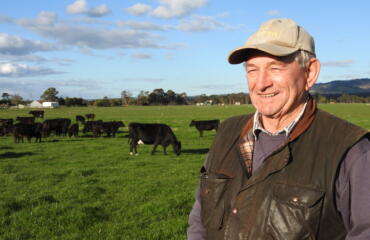For anyone who thinks moving away from industrial farming to embrace sustainable practices is for green hardliners only, conservation officer Jason McAinch has some news.
While there’s debate around just what qualifies as regenerative agriculture – and beyond that, what it delivers – by McAinch’s practical definition, it doesn’t require farmers to stop chemical use entirely. They may use small amounts of chemicals for difficult tasks like weed removal.
“If you’re an alcoholic and you go cold turkey, you’re not a very good human for a while. It’s the same with our landscapes,” says McAinch.

Bendigo conservation officer and “regen” leader, Jason McAinch. Photo: Gwen Liu
“If you take [chemicals and fertilisers] away, cold turkey, then it becomes angry and the transition is difficult.”
McAinch leads a practical regenerative agricultural communities program which began in Macedon Ranges in 2019 and extended across Hepburn and Greater Bendigo in 2021. The program responds to surging interest as farmers deal with soil damage, the rising costs of chemicals and fertilisers, and changing climate.
Broadly speaking, regenerative agriculture promises to improve rather than degrade landscapes. It’s often also promoted as a way of lowering a farm’s carbon footprint by encouraging biodiversity and enriching soil, though the science is still unclear on that front.
Typically, in the local Healthy Landscapes program, farmers plant trees and rotate livestock to encourage the activities of birds, bugs and grasses that enhance nutrients in the soil, reducing the need for chemical fertilisers.

Dirt to dirt: a regenerative farmer takes soil samples and looks at plant growth. Photo: Shutterstock
So far, more than 1000 people have participated in field days and webinars. Landowners of more than 150 properties have received site visits, advice and education. “People are queuing up to try and get onto that program,” says Bendigo Mayor Andrea Metcalf.
Younger farmers are more inclined to sign up than older ones, McAinch observes, but he’s confident that will change as the benefits become obvious.

Chi-uh Neylon, a fourth-generation farmer on her family’s sheep and chicken land in Longlea, is a case in point.

One Kyneton cattle farmer says he has lowered chemical costs per head by 95 per cent.
“The older generation – for example, my grandfather – was like ‘Why would you plant a tree?’ ” says Neylon.
“There’s this misconception that if you … plant out 30 per cent of your property in trees then you won’t be able to run as much stock,” says Neylon. “Actually, people usually find they can increase the stock once they’ve established rotation grazing and their soil has improved.”
McAinch and other practitioners believe healthier soil improves its ability to store carbon, and thus combat climate change, but scientists are not convinced.
“Over 25 years, you can’t actually measure a change in soil carbon,” says sustainable agriculture expert Professor Richard Eckard, a member of the Victorian Agriculture and Climate Change Council. “So, it’s not saying [that] won’t happen, but what it’s saying is that cause and effect are actually decades separated.”
Eckard, along with fellow University of Melbourne professors Rodney Keenan and Naomi Soderstrom, is researching investment in environmental agriculture. The collaborators say another challenge is that because the term is not well-defined, it’s difficult to measure the benefits.

Down and dirty: that we know so little about our soils is food for thought. Photo: Gwen Liu
Keenan says there is expert agreement that regenerative agriculture can make a farm “more resilient” to climate shocks like droughts, and that more research is needed.
“We know so little about the biodiversity in our soils,” observes McAinch.
“We know more about outer space than we do about our soils.”
Future Bendigo is a special regional reporting project produced by masters students in the University of Melbourne’s Centre for Advancing Journalism program in collaboration with the Bendigo Advertiser. All stories are co-published by The Citizen and the Bendigo Advertiser. The whole series can be found here.


